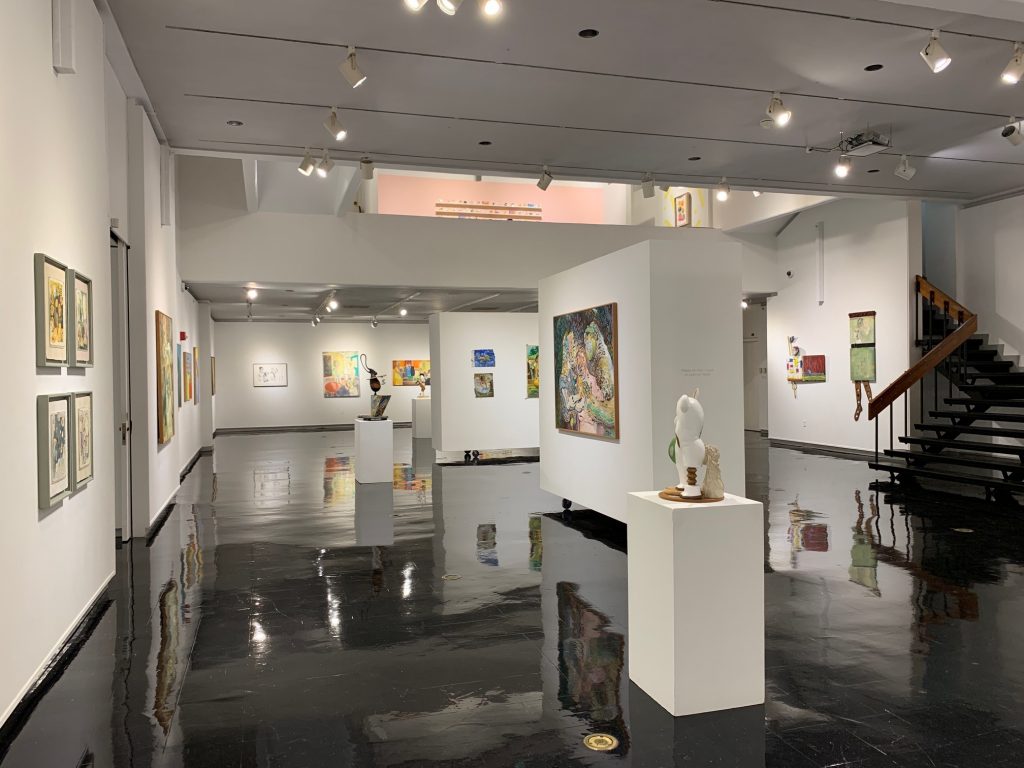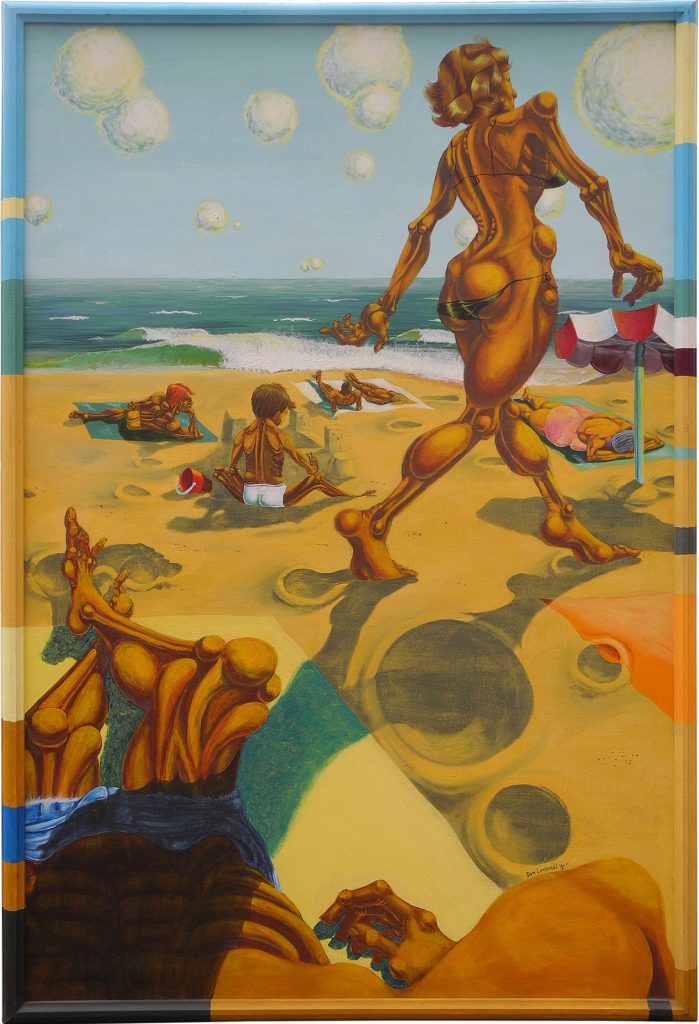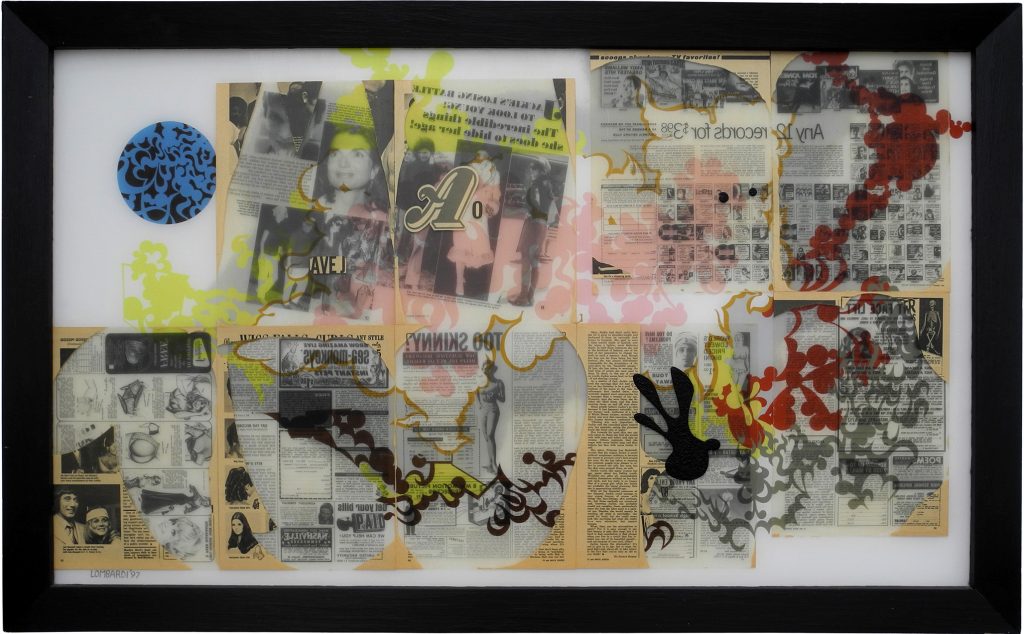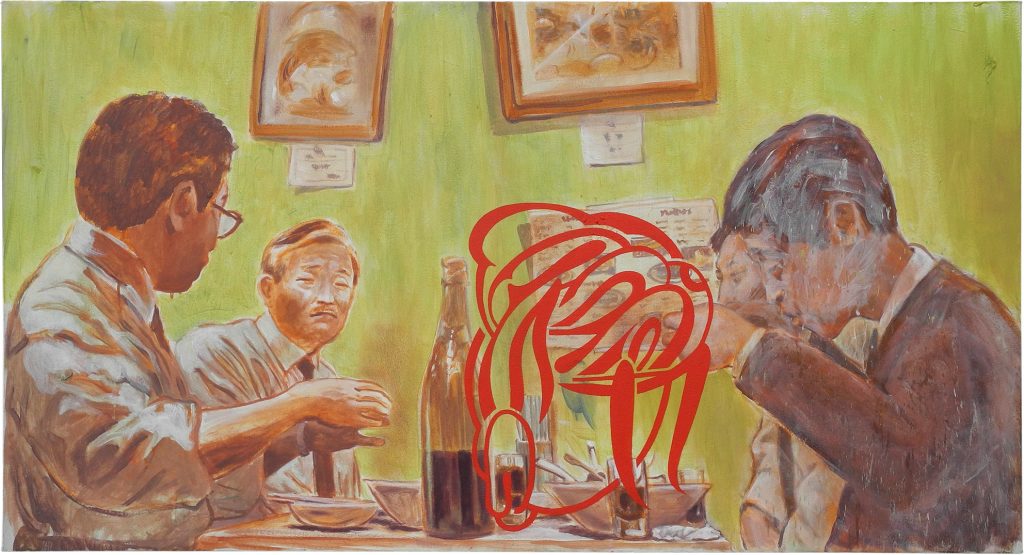by Antje K. Gamble

Curated by T. Michael Martin, the large retrospective at the Clara M. Eagle Gallery allowed for a deep look at the shifts throughout D. Dominick Lombardi’s almost five decade long career. From the more Surrealist inspired paintings to assemblage sculptures, High + Low engages with Lombardi’s playful experimentation of art and found materials and highbrow and lowbrow visual references.
The installation of High + Low at the Murray State University Eagle Gallery created cross-decade perspectives on developing themes in Lombardi’s work. (For full disclosure, I am on the faculty of Murray State University.) For example, in the opening space, Martin placed Lombardi’s earliest works from the 1970s with those just completed in 2019. This juxtaposition highlighted developments over time and, importantly, connections between Lombardi’s earliest and latest works.
Among his earlier works like Cyborg Sunbathers (1975), the use of the cyborg, like the Surrealist use of the automaton, engages a sense of the uncanny. The large central female figure casts a ominous shadow on the headless foreshadowed male laying at the bottom of the canvas. The main pair are of comparable size, while the others in the composition are much smaller in comparison. At the same time, the large ominous female figure’s import is in the visual effects of her present, which contrast with the logic of the rest of the painting. As a femme fatale type, her shadow looms large and in contrast to the logic of the rest of the painting. At the same time, the series of circles throughout the canvas from the figures’ joints, to the clouds, to the sandy footprints, carry though as a repeated pattern throughout a number of the later works in Lombardi’s oeuvre.

There are a number of larger currents to connect Lombardi’s career, which were already present in the early Cyborg series, where humanity has survived through the evolution and mechanization. Things like conspicuous consumption, pollution, and climate change show up in various ways throughout the exhibition in both his two and three dimensional works. For example, in the Need is Chance Rising (2015), Lombardi integrates found objects into an inventive tabletop sculpture. This simultaneously evokes humor and whimsy, but also unease. The detritus of a capitalist consumer society recycled out of necessity to create a monstrous, hybrid new figure. Like the cyborgs of his earlier series, his sculptural figures are ad hoc survivors.
Early on, his paintings begin to incorporate remnants of older canvases, newspapers, stickers, and even plexiglas to create a rich layering of images and meaning. Some of the most exciting aspects of these works are reminiscent Pop and Assemblage, from artists like Eduardo Paolozzi and Robert Rauschenberg. Starting in the 1990s, Lombardi’s Reverse Collage series creates visually dynamic layers of form and language. His use of newspaper clippings, create ghosts of the physical object whose materiality have been rubbed away. This creates an oscillation between recognition (like Jackie Kennedy in Reverse Collage #26, 1995) and obfuscation. Similarly, the Cross Contamination series channels the popular counter cultural use of stickers to cover the public visual landscape. The underlying paintings and digital prints serve, in various ways, to signal the past cultural norms being covered, updated, and altered by the younger generation and/or the new popular culture. The designed stickers have formal comparisons to his other works that come before; and serve, like the material manipulations in Reverse Collage series, to both reveal and hide layers of meaning.

The centrality of the idea of the “collective unconscious” in Lombardi’s conception of the work is used to explain all these aspects; and the exhibition includes a series of works titled Collective Unconscious. The Jungian concept focuses on the idea that archetypical imagery connecting humanity. Lombardi’s divergence from the Surrealist canon, which favored Freud’s more individualistic ideas, however, is still connected to an early twentieth-century Euro-American psychological discipline. In the end, Lombardi’s “collective consciousness” is decidedly from a particular American perspective. This, sometimes uncritical, American perspective is most clearly apparent in the Tattooed series. In the 2000s Tattooed series, Lombard uses overlaid designs reminiscent of popular tattoo designs on new or recycled canvases. According to the artist, the Tattooed series imagines a future breakdown of society when only children survive. In this future, the most important aesthetics are American tribal tattoos, which were designs originally culturally appropriated from Polynesian indigenous rites and popularized in the U.S. in the 1990s and 2000s. Here the tattooed overlays are painted as signals to the childish, debased, popular visual culture, but without a critical engagement with the nature of the source images as colonialist. As in the later the Tattooed Tokyo sub-series makes even more apparent, these serve as another form of colonial imperialism. Inspired by his trips to Japan and South Korea, this series reads as a kind of contemporary Japonisme.

